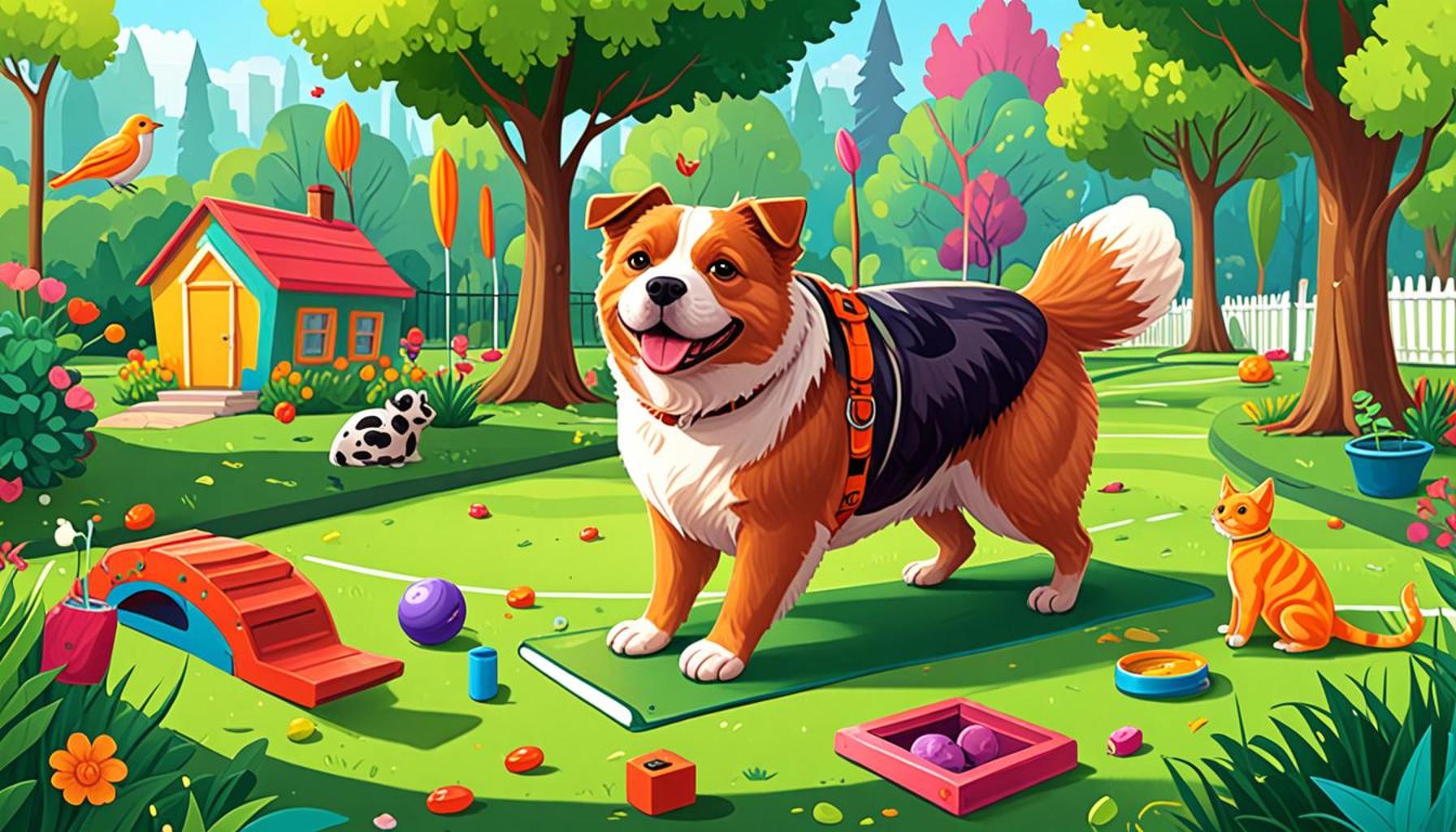Training Your Pet to Thrive in Different Environments: Home, Park, and Beyond

The Importance of Training Your Pet
Successfully training your pet to navigate various environments is not just a matter of obedience but a crucial component of enhancing their overall well-being and ensuring a harmonious relationship between you and your fur companion. Living in a range of environments, from bustling metropolitan areas to tranquil suburban neighborhoods, presents unique opportunities and challenges. It is important to realize that the experiences you provide for your pet can significantly affect their behavior and emotional state.
Home: The Foundation of Trust
Your home is the first environment your pet experiences, serving as the cornerstone of their training. A well-structured home routine fosters a sense of security. Start by establishing consistent feeding times and designated play areas. For instance, setting up a cozy corner with their bed and toys can help them feel safe and grounded. Activities like gentle grooming sessions or quiet cuddle time can reinforce your bond, providing comfort and trust. Behavioral cues, such as “sit” or “stay,” can also be practiced here to create discipline in a safe space.
Park: The Socialization Hub
Once your pet is comfortable at home, the next step is exposure to a park environment where socialization plays a crucial role. Parks provide valuable opportunities for pets to interact with other animals and people. Start small—perhaps with quiet times when less busy to encourage your pet to engage. This exposure is essential for shaping their behavior in new social situations. For example, if your dog becomes overly excited or anxious around other dogs, practicing commands like “leave it” or “come” can help reduce distractions and foster calm interactions. Negative experiences should be managed carefully to prevent lasting fears.
Beyond: Embracing Adventures
Exploring new places, from scenic hiking trails in the mountains to sandy beaches, can be thrilling yet comes with its own set of challenges. These outings are excellent for physical exercise and mental stimulation, both crucial for your pet’s health. While planning an outing, it’s vital to consider your pet’s temperament and readiness for new experiences. A quiet cat might find a crowded beach overwhelming, while an energetic dog would thrive on the excitement of a busy trail. Planning gradual exposure and ensuring they have a safe, secure harness can make these adventures more enjoyable. Incorporating training activities, like retrieving a toy during walks, can enhance both focus and fun.
Considerations for Training
Understanding how different environments impact your pet’s behavior is paramount. Factors like physical safety—helping them navigate hazards like busy roads—are essential. Always prioritize their psychological well-being; if you’re taking them into an unfamiliar environment, be sure they are comfortable and not overly stressed. Keep in mind potential social interaction challenges, as not all pets will react positively to new situations or stimuli.
By applying effective training techniques, your pet can develop the skills needed to thrive not just at home but in the wider world. With your patience and consistent efforts, you can transform potentially overwhelming experiences into positive and enriching adventures. Get ready to explore how to prepare your furry friend for all of life’s various escapades!
DIVE DEEPER: Click here to learn about your cat’s hunting instincts
Setting the Stage for Your Pet’s Training Journey
Understanding the significance of creating a positive foundation for your pet’s training journey is vital. The environments in which they grow and interact shape their behavior and emotional stability. Training your pet to navigate various spaces begins with consistent methods rooted in trust and recognition of their individual needs. By focusing on essential training techniques and concepts, you empower your pet to become a well-adjusted companion ready to tackle different scenarios.
Home: The Security Blanket
The first and foremost environment is your home, which acts as a secure base for your pet. A safe and structured home promotes confidence and trust, making it an ideal setting for training. Establishing a strong routine is key; your pet thrives when they can predict their surroundings. Here are some strategies to ensure your home remains a positive training ground:
- Consistent Feeding Schedule: Setting regular mealtimes allows your pet to understand when to expect meals, reducing anxiety around food.
- Designated Play Areas: Create specific zones in your home that are dedicated to play, sleep, and relaxation. This delineation helps your pet identify different activities associated with each space.
- Basic Command Training: Use this space to teach fundamental commands such as “sit,” “stay,” and “come.” These cues form the foundation for more advanced training and help establish discipline.
Your home should not merely be a place to live but a launchpad for your pet’s confidence. Engaging in activities such as puzzle games or training sessions within this environment enhances mental stimulation and reduces boredom, fostering a happier pet.
Park: Expanding Horizons
As your pet becomes more confident at home, the park serves as an excellent next step for their training. Parks offer an array of distractions, making them the perfect setting for practicing social skills and commands in more dynamic situations. Begin with calm, low-attendance times and gradually introduce your pet to busier periods. A few tips to maximize your park visits include:
- Safe Socialization: Allow your pet to engage with other dogs gradually; monitor their body language to ensure interactions remain positive.
- Focus Commands: Use commands like “leave it” or “come” to redirect your pet’s attention during exciting encounters, helping them remain calm amidst distractions.
- Positive Reinforcement: Reward your pet for good behavior in the park, establishing positive associations with both the environment and interactions.
It’s important to watch for signs of discomfort or anxiety as well—if your pet seems overwhelmed, retreating to a quieter area can help them recalibrate without lasting negative impacts.
Beyond: Embracing New Adventures
Once your furry friend has acclimated to home and park environments, the world outside beckons with new adventures waiting to be discovered. Exploring various locations—from hiking trails to public events—provides an exhilarating opportunity for further socialization and bonding. However, keep in mind that each outing should be well-planned:
- Assess Readiness: Gauge your pet’s temperament and prior experiences before introducing them to bustling scenarios.
- Gradual Exposure: Start with less crowded spots and slowly build up to busier areas, allowing your pet to adapt.
- Safety Measures: Invest in quality harnesses or carriers to ensure the safety of your pet during outings.
Through thoughtful training and gradual introduction to different environments, you can help your pet develop essential skills that lead to lasting happiness and confidence. Maintain a patient and observant approach, offering encouragement as they navigate each new experience. This journey not only strengthens your bond but creates a well-rounded and resilient companion ready for life’s varied adventures.
Training for Diverse Environments
When it comes to training your pet, understanding different environments is crucial for their overall well-being and adaptability. Each setting—from the serene confines of your home to the bustling atmosphere of a park—presents unique challenges and opportunities for growth. Here’s how to approach training your pet to thrive in each of these environments.
Home: Creating a Safe Haven
Your home is the first environment your pet encounters. It’s essential to establish a positive training atmosphere. Focus on consistent routines, which help pets feel secure. Utilize commands such as “sit,” “stay,” and “come.” These foundational commands lay the groundwork for leash training and outdoor activities.
Encourage mental stimulation within your home using puzzle toys and interactive games. This not only keeps your pet engaged but also prepares them for new experiences outside.
Park: Engaging with the Outside World
Transitioning training to a park setting introduces distractions that can challenge your pet’s focus and compliance. Begin in a quieter area of the park to gradually expose your pet to others, sounds, and smells. Reinforce basic commands and teach them how to interact with other dogs and people appropriately. Reward positive behavior with treats and praise, reinforcing their confidence and social skills.
Beyond: Adapting to New Surroundings
As your pet masters training at home and in parks, it’s time to explore new places. Take them to different environments—like busy streets, beaches, or even dog-friendly stores. Each new location helps your pet adapt to varying sights, sounds, and smells. Remember, patience is key. Allow your pet to explore at their own pace, ensuring they feel secure and unthreatened.
Ongoing Training and Socialization
Ongoing training is crucial as environments change. Frequent outings and varied locations not only reinforce your pet’s training but also enhance their socialization skills. The goal is to have a well-rounded pet who exhibits positive behavior in any setting. This adaptability enriches their life and deepens the bond you share.
| Category | Benefits |
|---|---|
| Home | Familiarity breeds comfort and enables the establishment of foundational training. |
| Park | Exposure to distractions enhances their focus and social skills through positive reinforcement. |
| Beyond | New environments promote adaptability and ensure confidence with varied stimuli. |
This ongoing approach ensures your pet is not only trained but also well-adjusted, making every outing together a joyful experience. Engaging with these diverse environments helps formulate a well-rounded lifestyle for your furry companion.
LEARN MORE: Click here for essential tips post-adoption
Mastering Public Spaces: A Wider World Awaits
Once your pet has experienced the comfort of home and the excitement of the park, the potential to develop a well-adjusted companion only increases as you extend training into public spaces. Neighborhood streets, busy markets, and outdoor festivals present unique challenges but also rewarding experiences that are pivotal for your pet’s socialization. The key is approaching each new environment with thoughtful strategies and preparedness.
Urban Adventures: Navigating Busy Streets
Training your pet in urban settings can significantly bolster their confidence. Urban environments are often bustling with activity—loud noises, unfamiliar sights, and a diverse array of people and animals. To navigate these situations successfully, keep the following in mind:
- Desensitization Techniques: Gradually introduce your pet to the urban hustle. Start with quieter streets and slowly progress to busier areas while observing their comfort levels.
- Leash Etiquette: Reinforce leash training in these environments, ensuring your pet understands walking calmly beside you despite the chaos around them.
- Controlled Exposure: Set specific goals for each outing, whether it’s encountering a skateboarder, passing a construction site, or meeting new people. Reward your pet for remaining calm and focused.
With patience, your pet will learn to handle urban distractions, making walks enjoyable for both of you while reducing potential stress or anxiety.
Public Transportation: A New Challenge
Taking your pet on public transportation—be it buses, trains, or subways—can seem daunting, yet it offers an excellent chance for training. Many cities in the U.S. embrace pet-friendly policies, allowing you to introduce your companion to new experiences within a confined space.
- Familiarize in Advance: Consider visiting transportation hubs at off-peak times to let your pet explore the sights, sounds, and smells without pressure.
- Train for Confinement: Use practice sessions in small, controlled settings such as a backyard or a contained area to prepare your pet for the sensation of being indoors on public transit.
- Bring Essentials: Pack essential items for your pet, such as water, snacks, and comfort toys, to manage potential stress during the ride.
The experience can be enriching for both of you, as navigating public transportation enhances your pet’s adaptability and social skills.
Community Events: The Final Frontier
Community events, such as craft fairs, dog shows, or outdoor concerts, provide a fantastic platform for honing your pet’s social skills while you both engage with the community. These settings involve various distractions and interactions, but with proper preparation, they can be rewarding learning experiences.
- Set Realistic Expectations: Start with smaller events to help your pet acclimate to crowds and new stimuli, gradually venturing into larger gatherings as their confidence grows.
- Private Space: Create a “safe zone” during events where your pet can retreat if they feel overwhelmed. A portable crate or a designated blanket can offer them a sense of security.
- Engage with Others: Encourage socialization with other pets and people by allowing your pet to meet friendly participants, reinforcing positive interactions with praise and rewards.
Training your pet to thrive in community settings not only fosters a strong sense of belonging but enhances their adaptability, making outings enjoyable rather than daunting.
DISCOVER MORE: Click here for essential training tips
The Path to a Well-Rounded Companion
Training your pet to thrive in diverse environments—such as home, parks, and the wider world—is crucial for fostering their well-being and enhancing your relationship. From the comfort of familiar spaces to the bustling energy of urban streets and public transportation, every setting offers unique opportunities for growth and adaptability. By employing desensitization techniques, reinforcing leash etiquette, and providing a safe retreat during overwhelming moments, you equip your pet with the skills to navigate these experiences with confidence.
Moreover, engaging in community events allows for invaluable social interactions that build resilience and trust. Set realistic goals and celebrate small victories to keep the training positive and enjoyable. Remember, each successful outing not only benefits your pet’s socialization and adaptability but also enriches your own life, as you explore new environments together.
The journey of training your pet is not only a path to obedience but a celebration of understanding their needs and capabilities. As you commit to this process, you cultivate a bond that thrives amidst the variety and excitement of life beyond the home. So, whether you’re hitting the park or stepping onto a crowded subway, remember that every moment spent training your pet is an investment in their happiness and your shared experiences. Start your training journey today, and watch your pet flourish in every corner of their world.



